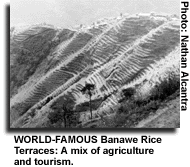| TravelSmart.NET
Archive Home |
|
| Inquirer.NET
Home |
|
| TravelSmart.NET
Home |
|

Rewarding inn keepers
as well as farmers
By Maribelle Dulnuan
Ifugao
 SOMEWHERE along the steep forested mountains of Northern
Luzon, about 2,000 meters above sea level, is Ifugao, home of
the world-famous Ifugao rice terraces.
SOMEWHERE along the steep forested mountains of Northern
Luzon, about 2,000 meters above sea level, is Ifugao, home of
the world-famous Ifugao rice terraces.
Each year, about 18,000 tourists travel eight to 10 hours over bumpy terrain to see this man-made beauty declared by the United Nations as a World Heritage Area.
Scientists, writers and researchers, on the other hand, come and try to dissect the intricacies behind these rice paddies etched in steepest pitches by Neolithic aborigines with the barest and crudest tools some 1,200 years ago.
''Seminars and conferences talk these days about sustainability as if it is a new thing. But here it had been a practice for a thousand years,'' said Dr. Carlos Andam, principal investigator of an Earthwatch study on the rice terraces.
 The terraces, which date back to the 7th Century,
are the longest-running sustainable agriculture in the world.
But for how long will this claim hold true?
The terraces, which date back to the 7th Century,
are the longest-running sustainable agriculture in the world.
But for how long will this claim hold true?
Agricultural experts today claim that the indigenous rice varieties grown in the terraces are low-yielding. Not to mention the media releases claiming the terraces are now spewing with giant earthworms, their paddies crumbling due to lack of water, and so on.
Thus, technicians agree that the terraces are no longer ''productive'' for local farmers.
''Good for the shop, inn and restaurant owners because they directly benefit from tourists who come to see the terraces we have worked hard for decades,'' said Apu Bugan, her back now bent but still strong enough to climb the terraces.
With only one cropping season plus the decrease in the proportion of the planting area yearly, the terraces are not sufficient to support the increasing population.
Farmers admit that their yearly harvest is just enough to sustain them for five to six months. The rest of the year, farmers have to buy commercial rice and plant camote (sweet potato) and other root crops for supplement.
In 1974, experts from the International Rice Research Institute in Los Baños, Laguna, tried to address this problem through experimental planting of high yielding varieties on the terraces. Their first variety, RPKn-2, was developed in 1977 but was not accepted by local farmers.
IRRI left its field station in Banaue, Ifugao's capital town, after more than 20 years without introducing a single rice variety appropriate to adverse environment and Ifugao sensibilities.
Two years ago, experts from the Philippine Rice Institute based in Muñoz, Nueva Ecija, introduced two high yielding rice varieties suitable to the environment of the terraces.
Named after the Ifugao and Kalinga rivers, the Gohang and Sumadel varieties can yield three to four tons of rice per hectare while the traditional variety produces only two tons.
PhilRice claims the Sumadel variety can produce two croppings in low elevated terraces compared to only one harvest per year for the traditional variety.
Both varieties were released by PhilRice for reproduction after conducting five trail seasons and a taste test. Unfortunately, after two to three croppings, local farmers dropped the varieties. Experts calculated only 3 percent acceptability rate from farmers.
Andam, who worked in Banaue for several years under an agricultural development agency, says experts cannot solve the problem by merely telling the farmers to throw the rice they have been planting since time immemorial and give them ''alien'' high-yielding varieties to plant.
Sustainability of the terraces for Andam is one that perpetuates the ancient Ifugao terraces experiment measured in centuries instead of seasons.
''The adaptability of technological change is a very important factor in improving terrace productivity. This explains that in view of the results of earlier attempts to introduce new varieties, the farmers would still go back to the old ones even if they found out that the new varieties exhibited much higher yields,'' he said.
Andam has reasons to believe that the indigenous rice varieties are not low-yielding as claimed by agriculturists and researchers.
He says based on yield reports from local and international authors, there is a dramatic increase in the level of productivity in the area.
In 1979, experts reported a yield level of two tons per hectare. The following year, production increased to five tons per hectare. In 1986, PhilRice came up with a yield level of 2-2.5 tons per hectare in higher elevations, and in 1884, the Central Cordillera Agricultural Program, a development agency funded by the European Union under the Department of Agriculture, revealed a yield level of 2.4 to 5.7 tons per hectare depending on the rice variety.
Andam says a 1995 research has revealed that based on population of the terraces, a yield level of four tons per hectare can support twice the 1990 population even without changing the existing rice variety and cropping intensity.
Andam's project with Earthwatch, an international organization supporting scientific field researches on environmental issues, aims to validate these data to measure the productivity of the Banaue rice terraces.
He says this would greatly influence the quality of development plans, evaluation of the current development efforts as well as future sustainable development decisions in the area.
A team of rice experts recently interviewed Ifugao farmers about their crops that grow in the margins of their rice terraces as well as the native technology used in their cultivation or other agricultural practices, to measure of overall productivity and sustainability of the terraces.
Andam says tourists who visit Banaue to admire the
rice terraces must reward the farmers, not just shopkeepers, or
the terraces will disappear.
![]()